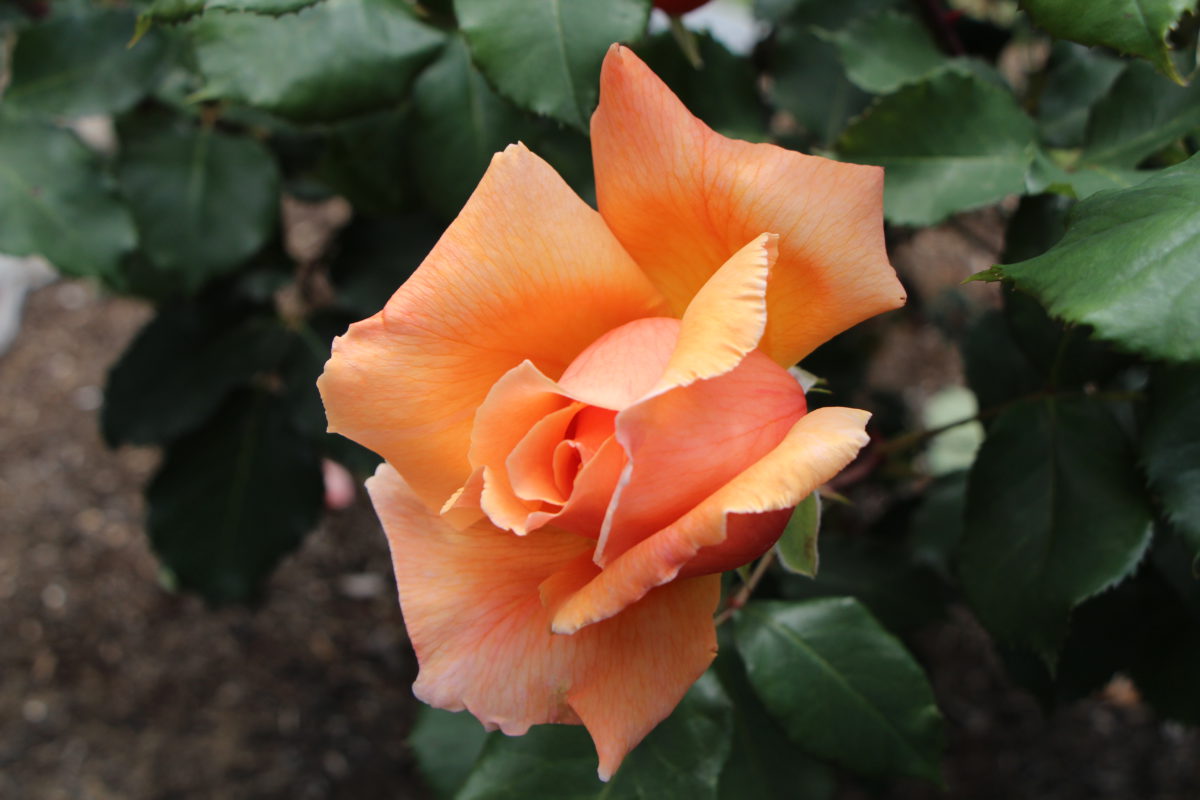
Growing roses in western Washington can be challenging. You will have more success if you choose and site them carefully and give them the right care. Annette Frahm photo.
Roses are in bloom right now in Seattle. Many people love the beauty and fragrance of roses. But growing roses in western Washington can be challenging. Our moist, cool weather is ideal for diseases such as black spot, rust and powdery mildew.
Roses are high-maintenance plants in our region. They are not part of our regular tree and shrub care program. Still, you can grow roses here if you take steps to reduce problems.
Selecting roses
Purchase disease-resistant plants. “Disease-resistant” doesn’t mean your rose is guaranteed to be problem-free. Your rose may still get black spot or powdery mildew, but it is less likely to succumb to diseases.
Here are a few lists of roses that are likely to perform well in our damp conditions.
- Seattle Rose Society: Roses for Puget Sound Gardens
- Great Plant Picks: Rose list
- Olympia Rose Society: Recommended roses for the south Puget Sound area
- North Coast Gardening: Disease-resistant roses for the Pacific Northwest
Planting roses
Plant roses where they get plenty of sun—at least six hours a day.
Roses need good air circulation to reduce problems with fungal diseases. Plant bushes at least three feet apart to encourage air flow, and don’t plant close to buildings or other plants.
Find a spot with good drainage. Roses may not survive our rainy winters if they have “wet feet” or sit in water.
Here are detailed instructions on planting roses from WSU Extension.
Here is our infographic on planting and watering a new plant.
Growing roses: mulch and fertilizer
Spread a two- to three-inch layer of mulch around each plant, keeping the mulch a few inches away from the trunk. Mulch can help prevent disease spores from reaching the plant. Add new mulch every year to reduce the spread of disease.
Mulch will also conserve moisture, control weeds, improve soil structure and protect roots from hot and cold weather.
Fertilizer is helpful for abundant blooms. Local garden expert Ciscoe Morris recommends a mixture of organic rose food and alfalfa meal. See details here.
Growing roses: water
Roses need regular water. Water at least twice a week in dry summer weather. Avoid overhead watering to keep the foliage dry. This will help reduce the spread of disease.
Water roses deeply to soak the entire root zone. Frequent, shallow watering may encourage fungal diseases and won’t reach deeper roots.
Growing roses: pruning
Do not prune your roses too early. A good time to prune roses is March 1st. Pruning too early can force growth that can be susceptible to a cold spell.
When pruning, always prune out all the dead and diseased wood. Cut out the old wood by cutting below the wood into healthy tissue.
Prune to open the center of the bush for maximum air circulation. Pruning cuts should be done so that the upper bud is facing the outside of the plant.
A good rule of thumb is to leave no wood on the rose bush that is thinner than a pencil.
Roses require and respond well to proper pruning. Here are two good sources on how to prune your roses.
- Plant Amnesty: YouTube playlist on pruning roses.
- Better Homes and Gardens: article on tips for pruning roses.
Managing diseases
Remove all leaves up to 1 to 1-1/2 feet off the ground to prevent water and disease spores from splashing onto them.
Remove all diseased leaves and blooms regularly. Do not compost them in your home compost bin. They need to be composted in high heat to kill disease spores.
Powdery mildew (but not black spot): Put one teaspoon of baking soda into a quart of water. Add a few drops of dishwashing liquid (not detergent). Spray the mixture weekly in spring before disease symptoms appears. The baking soda alters the pH of the leaf surface enough that disease organisms find it difficult to colonize the surface.
Black spot and rust: Some less-toxic fungicides are on the market. They contain sulfur, neem oil, copper or potassium bicarbonate (similar to baking soda).
Fungicides will not cure leaves that infected with fungal diseases, but they can help prevent healthy leaves from becoming infected.
In Harmony doesn’t advise any other treatment for rose diseases. Most other fungicides are toxic to humans and the environment.
You may need to accept that your roses will get some black spot. The blossoms will still be gorgeous.
Managing aphids
Aphids are a common rose pest. Inspect your plants often. If you find aphids, remove them from the affected leaves or gently smash them between your thumb and forefinger. Be careful not to bruise or damage leaves or buds.
Another option is to wash off your plants with a gentle stream of water from the hose. Avoid using a spray nozzle. This can damage buds and leaves.
You could encourage beneficial insects that eat aphids by planting nectar-producing plants. Using an insecticide to kill aphids will also kill the good guys that eat them.
Stop and smell the roses
Scientific research shows that we are happier when we take time to appreciate the things and people in our lives.
This post is updated and expanded from our most popular blog post ever on growing roses in western Washington. It is clear that despite the difficulties in our challenging climate, people love roses and will continue to grow them.
Enjoy your blooms!

We want to grow roses for my sons wedding. When do they bloom in Western Washington?
Depending on the variety, your roses should start blooming in early spring. Many modern roses bloom a few times during the summer, sometimes into early fall.